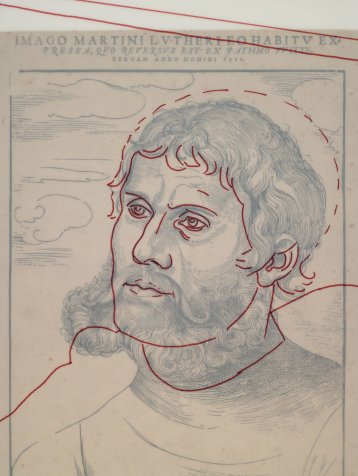
Critical Catalogue of Luther portraits (1519 - 1530)

Edited by Anselm Schubert, Daniel Hess, Gunnar Heydenreich, Oliver Mack and Andreas Maier
Catalogue entries by Daniel Görres, Amalie Hänsch, Thomas Klinke, Wibke Ottweiler and Aline Sindel
in cooperation with Vincent Christlein
Martin Luther’s importance in religious and cultural history is undisputed, and there are few people of the age whose portrait is depicted more often. However, in contrast to his works, the contemporary portraits, which are just as important for the history of his influence, have been neither completely compiled nor critically examined. To mark the anniversary of the Reformation in 2017, these portraits were disseminated and marketed worldwide via mass media, even though there is some uncertainty as to the historical context in which they were used, the date of their production and their authenticity. More recent examinations have shown that individual key works that were believed to be authentic were in fact produced later than assumed and thus appear to idealise the reformer through iconography after the fact.
In view of this, a critical cataloguing of the early Luther portraits (1519–1530) is desirable from a scientific and cultural policy perspective. With its interdisciplinary approach covering art history, art technology, reformation history and computer science, the project addresses both the methodological and content-related requirements. Project work will be based on creating a catalogue of autonomous portraits of Luther from the genres of painting and prints that can be attributed to the period under investigation, 1519 to 1530, or are the subject of discussion of this time. The wealth of portraits of Luther, particularly in the form of prints, will be digitally recorded in the project in the highest possible resolution.
The early modern portrait using Luther by way of example
The body of works featuring portraits of Luther offers an ideal opportunity to consider in detail the mode and context of portraiture in the first half of the 16th century. We must examine whether the question of authenticity and the naturalistic representation ad vivum should be interpreted as expressing an understanding of nature and personality, or rather whether a new discussion is needed in the multi-layered context of formulaic assignation and bringing to life, representation and group formation, memoria and propaganda.
New approaches to material analysis using computer science
With pattern recognition methods specially developed for the project, high-resolution images of the paintings and prints will be objectively analysed to determine their similarity. The recorded similarities and differences can give hints as to the degree of wear of the printing plates and blocks, for example. This allows us to draw conclusions regarding their production and also possibly methods to transfer across genres. Recurring, visually striking image patches will be automatically detected and evaluated based on a quantitative similarity measure. Established pattern recognition methods and the latest approaches in the application of deep learning will be deployed to find similarities. In particular, results of imaging research methods such as infrared reflectography will also be used.
Art technology examination
To establish a foundation for the most reliable possible art historical categorisation and contextualisation, the project will examine selected portraits using physical analysis procedures and scientific methods. New findings regarding material properties, the working process, painting technique characteristics and changes in the state of the portraits should significantly deepen our understanding of these works. Comparative examinations can also reveal information about the production of series of images in the 16th century. The examination of the painting surface will including determining the types of wood used and, where possible, more accurately pinpointing the age by means of dendrochronology. Analyses of the sheet parameters, paper structure and watermarks are planned for the prints. These can also provide important indications of the place of use and/or dating of the paper. Radio-diagnostic surface examinations permit an analysis of the image structure, the identification of any changes in the process of production and subsequent changes caused by ageing or restoration work. Infrared reflectograms help to visualise the signatures on paintings. In addition to giving insights into the composition of the pictures, the analysis of the signatures helps us understand the process by which the paintings were developed. This can reveal whether the drawing was made freely on the painting base or was transferred from a cartoon, for example.
Critical evaluation of historical sources
From 1519, Martin Luther’s writings often included a printed likeness of the author. These images are among the earliest examples that can be dated based on the publication date. A systematic recording of these images will be used as the starting point for critical research into the various sources that have been passed down for posterity. This will be accompanied by the most exhaustive possible inspection and evaluation of the sources on the creation and use of the portraits of Luther up until 1530 (reports concerning contexts of use, the burning of images, etc.). One important aspect will constitute research relating to a typographic analysis of the inscriptions on printed images of Luther, something which has to date been less widely examined. Ideally, this will permit a chronological and topological attribution, and thereby supplement the watermark analysis. Contemporary sources will also be used to question whether the productive collaboration between Lucas Cranach the Elder and Martin Luther must necessarily be viewed in the context of the existing narrative, namely that of a close friendship. This examination could lead to a re-evaluation of the thesis that the images were produced in direct relation to biographical Events.
Project team
- Germanisches Nationalmuseum, Nuremberg
Prof. Dr. Daniel Hess
Oliver Mack M.A.
Daniel Görres M.A.
Dipl.-Rest. Wibke Ottweiler - Friedrich-Alexander-University Erlangen-Nuremberg, Institute for Church History
Prof. Dr. Anselm Schubert
Amalie Hänsch M.A. - University of Applied Sciences, Cologne
Cologne Institute of Conservation Sciences
Prof. Dr. Gunnar Heydenreich
Dipl.-Rest. Thomas Klinke
Advanced Media Institute
Prof. Christian Noss
Jorge Pereira B.Sc.
Volker Schaefer B.Sc. - Friedrich-Alexander-University Erlangen-Nuremberg, Pattern Recognition Lab
Prof. Dr.-Ing. habil. Andreas Maier
Dr.-Ing. Vincent Christlein
Aline Sindel M.Sc.